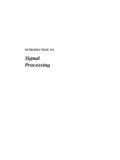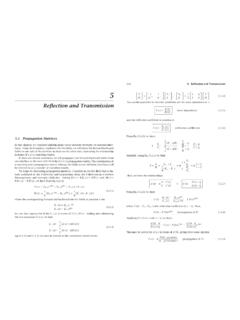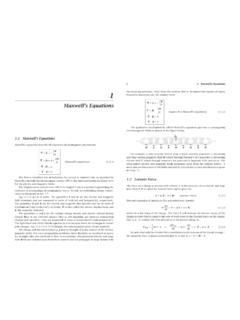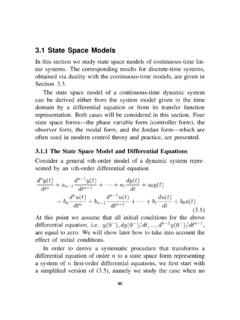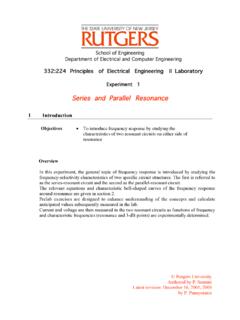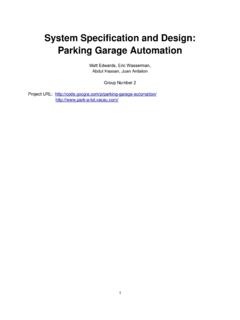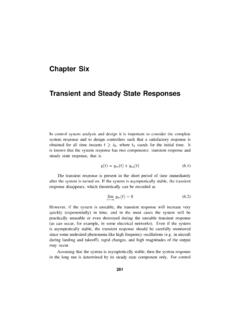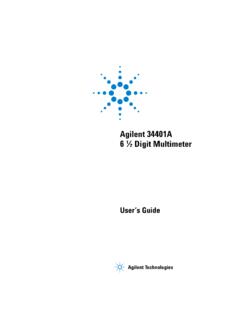Transcription of Frequency Response of Filters - Rutgers University
1 Rutgers UniversityAuthored by P. SannutiLatest revision: December 16, 2005, 2004by P. PanayotatosSchool of EngineeringDepartment of Electrical and Computer Engineering332:224 Principles of Electrical Engineering II LaboratoryExperiment 2 Frequency Response of Filters1 IntroductionObjectives To introduce Frequency Response by studying thecharacteristics of two resonant circuits on either side ofresonanceOverviewThis experiment treats the subject of Filters both in theory as well as with realized Low Pass, High Pass, Band Pass, Band Reject and All Pass Filters are introduced. Thesefilters are characterized by their Frequency Response that indicates how near-ideal their filteroperation actually is. Filters of different specifications are realized as mostly 2nd order activefilters utilizing op-amps. Their Frequency Response (mostly the magnitude part but the phasepart as well) is measured and the cut-off frequencies are ideal filter is a network that allows signals of only certain frequencies to pass whileblocking all others.
2 Depending on the regime of frequencies that are allowed through or notthey are characterized as low-pass, high-pass, band-pass, band-reject and all-pass. There aremany needs for electric Filters , some of the more common being those used in radio andtelevision sets, which allow tuning in a certain channel by passing its band of frequencieswhile filtering out those of other channels. The Frequency Response is divided into magnitude(amplitude) and phase parts. The amplitude curve of a filter will indicate how closely thepractical circuit imitates the ideal filter characteristics that are as follows:Notice that, depending on the relative magnitude of their corner frequencies, a low pass inseries with a high pass can either completely block all signals or give a band reject. By thesame token, a low pass in parallel with a high pass can give either a bandpass or an all ideal characteristics will at best be approximated by real circuits.
3 How closely thiswill be achieved will depend on the Frequency Response of the particular circuit. The designof electric Filters is based on a compromise between deviation from ideality vs. complexity(and cost). The order of the polynomial being used (thus the order of the filter) is the major 1 The subject is treated in detail beginning with section of the text.!!c!!c2!c1 Low pass!!cHigh pass!!c2!c1 Bandpass!!cAll passBandreject|V(j!)||V(j!)||V(j!)||V(j! )||V(j!)|PEEII-IV-3/15indicator: the higher the order2, the more complex the circuit and the closer the frequencyresponse to the ideal curve. Filter operation is considered when the amplitude of the outputsignal of the circuit is relatively large for some frequencies and small for others. Then onecan say that for the former the signal passes and for the latter it does Low Pass FilterA low pass filter is a circuit whose amplitude (magnitude) function decreases as !
4 Increases, that is, the circuit passes low frequencies (relatively large amplitudes at theoutput) and rejects high frequencies (relatively small amplitudes at the output) asshown in fig. ()!Hj()!maxHj()!max(2)1/2!c!0In fig. 1, !c is defined as the (3 dB) Frequency , that is the Frequency at which theamplitude is (1/2)1/2 = times the maximum amplitude. It is traditional to considerthe 3 dB Frequency as the cutoff Frequency . That is, a low pass filter is said to passfrequencies lower than !c and reject those that are higher than !c. In other words, thepass(ing) band is ! < ! High Pass FilterA high pass filter is a circuit whose amplitude Response increases with ! as shown infig. 2. 2 The subject is treated in detail beginning with section of the 1 Low Pass FilterMagnitude Portion ofFrequency ResponsePEEII-IV-4/15Hj()!
5 Hj()!maxHj()!max(2)1/2!c!0 This filter passes frequencies that are higher than the cutoff Frequency !c and rejectsthose that are lower than !c. That is, the pass band is ! > ! Band Pass FilterA band pass filter is a circuit which passes the band of frequencies centered around !0as shown in fig. !c2!!0!Hj()!Hj()!maxHj()!max(2)1/20 Fig. 2 High Pass FilterMagnitude Portion ofFrequency ResponseFig. 3 Band Pass FilterMagnitude Portion ofFrequency ResponsePEEII-IV-5/15!0 is the Frequency at which the maximum amplitude occurs, and is called the centerfrequency. The band of frequencies that passes, or the pass band, is defined to be !c1 ! !c2, where !c1 and !c2 are the cutoff (3 dB) width of the pass band, given by B = !c2 - !c1 is called the All Pass FilterThe all pass filter is one whose amplitude is constant, thus, it passes all frequenciesequally well as shown in fig.
6 4. It is usually put in a cascade when it is desired to keepthe amplitude part of the Frequency Response unaltered but shift the phase as ()!Hj()!max! Band Reject FilterThe band reject filter is one that passes all frequencies except a single band. A typicalamplitude Response of a band reject filter is shown in fig. ()!max(2)1/2Hj()!Hj()!maxc1!c2!!0 Fig. 4 All Pass FilterMagnitude Portion ofFrequency ResponseFig. 5 Band Reject FilterMagnitude Portion ofFrequency ResponsePEEII-IV-6/15As shown in fig. 5, the band reject filter passes all frequencies that are greater than !c2and smaller than !c1. Its stop band is !c1 < ! < ! of Op Amps3 Filters realized with RLC circuits have limited performance. Filters incorporating suchpassive elements in addition to active elements such as op amps exhibit bettercharacteristics and are called active +Av=- Vi+-V-V+Ri+-V0R0 Inverting InputNon-Inverting InputFig.
7 1 Operational AmplifierCharacteristics of an Ideal Op Amp1. Input Resistance Ri = ": An infinite input resistance means that no current flows intoor out of either of the input Output Resistance Ro = 0: In this case the output voltage Vo is independent of theoutput current3. Open Loop Voltage Gain =AV = "5:In order to predict the behavior of an operational amplifier when circuit elements areexternally connected to its terminals, one must understand the constraints imposed on theterminal voltages and currents by the amplifier itself. Those imposed on the terminalvoltages are as follows :V0 = AV (Vp Vn) (1)and 3 A somewhat more detailed description can be found in part 2 of Principles of EE I lab IV and a full description insections of the The subject is treated in detail in chapter 15 of the The sign of Av (whether positive or negative) depends on the definition of Vi which of the two input terminalsis defined as the reference.
8 If Vi is defined as (Vn Vp) then Av is <0; if defined as (Vp-Vn) then it is > =-VCC V0 +VCC = V+ (2)Eq. 1 states that the output voltage is proportional to the difference between Vp and the output voltage Vo is to be finite6 it follows from the definition of voltage gain, thatVi = Vo / Av will go to zero when Av is infinite. This, however, assumes that there is someway for the input to be affected by the output. Indeed this will only happen if there isnegative feedback in the form of a connection between the output and the invertingterminal (closed loop operation). For closed loop operation, it is said that a virtual shortexists between the inverting and noninverting input terminals. This means that if an OpAmp is operating in its linear region (if it is unsaturated) then Vi = 0, or equivalently Vn = 2 states that the output voltage is bounded.
9 In particular, V0 must lie between VCC, thepower supply voltages. Else V0 will be at either limiting value, and the Op-Amp is thensaturated. The amplifier is operating in its linear range so long as |V0| < |VCC|.-+741+15V-15V2374612348765 Top ViewFig. 2 741 OP-AMPThe chip layout is shown in Fig. 2. The standard procedure on a DIP is to identify pin 1 withthe notch in the end of the chip package. The notch always separates pin 1 from the last pinon the chip. In the case of 741, the notch is between pins 1 and 8. Pins 2, 3, and 6 are theinverting input Vn, the non-inverting input Vp, and the amplifier output Vo three pins are the three terminals that normally appear in an op-amp circuit schematicdiagram. The null offset pins (1 and 5) provide a way to eliminate any offset in the outputvoltage of the amplifier. The offset voltage is an artifact of the integrated circuit.
10 The offsetvoltage is additive with pin Vo (pin 6 in this case), can be either positive or negative and isnormally less than 10 mV. Because of its small magnitude, in most cases, one can ignore thecontribution of the offset voltage to Vo and leave the null offset pins open. 6 or rather unsaturated since when Vo tries to become larger than V+ or smaller than V- it gets clamped to V+ or V-respectively (or to a constant voltage somewhat less).PEEII-IV-8/153 Prelab Show why the cutoff Frequency (or the Frequency at which the output amplitude is (1/2)1/2times the maximum output amplitude) is called the 3 dB (a) Determine the amplitude Response and the phase Response functions for the low pass filtershown in fig. 7.(b) Determine the maximum amplitude of the output.(c) Determine the 3 dB Frequency and its corresponding Repeat for the high pass filter shown in fig.
